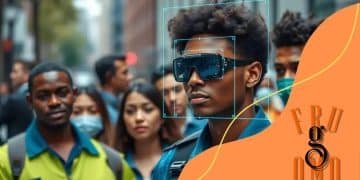AI-driven misinformation detection tools: combatting false narratives

AI-driven misinformation detection tools use advanced algorithms to analyze vast amounts of online content, swiftly identifying and flagging false information to enhance the credibility and safety of digital platforms.
AI-driven misinformation detection tools are changing the game in how we confront false narratives. With the rise of digital misinformation, it becomes crucial to explore how AI can enhance our defense against deception.
Understanding AI-driven misinformation
Understanding AI-driven misinformation is essential in today’s world. As information spreads rapidly online, so does false information. Tools designed to combat this issue play a crucial role.
AI technologies can analyze large amounts of data to identify patterns typical of misinformation. With their ability to constantly learn, these systems improve over time, making them a valuable resource in the fight against false narratives.
Key Features of AI-driven Misinformation Tools
These tools often include advanced algorithms that help in detecting misleading information. Here are some vital features:
- Real-time analysis: Quickly assesses data to flag potentially harmful content.
- Source verification: Confirms the credibility of information sources.
- Contextual understanding: Analyzes the context of information rather than just the words used.
- User engagement: Provides feedback and alerts to users about questionable content.
Moreover, social media platforms utilize AI-driven misinformation detection to create safer online environments. This is achieved through continuous monitoring of posts and interactions.
It’s fascinating how these technologies can help users discern credible content from misleading sources. As algorithms evolve, the efficacy of these tools in filtering misinformation continues to enhance, making them indispensable in our digital age.
How these tools work
Understanding how AI-driven misinformation detection tools work is vital for appreciating their role in today’s information landscape. These tools harness the power of artificial intelligence to analyze data streams and identify misleading content.
At their core, these tools use complex algorithms to scan vast amounts of information in real time. This allows them to flag content that exhibits signs of misinformation.
Key Mechanisms Behind the Technology
Several mechanisms make these tools effective:
- Natural Language Processing (NLP): This allows the software to understand and interpret human language, uncovering nuances and meanings.
- Machine Learning: Algorithms learn from past data to improve accuracy, adapting to new patterns of misinformation.
- Data Cross-Verification: Tools can verify information against multiple trusted sources to ensure reliability.
Furthermore, the integration of user feedback helps these tools refine their accuracy and responsiveness. By learning from interactions, they become sharper in distinguishing between credible information and false narratives.
The ability to process information quickly is another significant advantage. This swift analysis means that misleading content can be flagged before it spreads widely.
As technology advances, the methods these tools employ continue to evolve. This ongoing development ensures that we are better equipped to handle the challenges posed by misinformation in the digital age, making the pursuit of truth more attainable.
Applications in social media

The applications of AI-driven misinformation detection tools in social media are transforming how we engage with information. As misinformation spreads rapidly on these platforms, these tools become crucial in identifying and mitigating false narratives.
Social media sites deploy algorithms that scan user-generated content to flag misleading information. This proactive approach helps to prevent the viral spread of false claims. Users are often alerted when they encounter questionable content, fostering a more informed online community.
Benefits of AI in Social Media
Implementing these tools brings several advantages:
- Rapid detection: They can identify and respond to misinformation almost instantly, limiting its reach.
- User safety: By flagging falsehoods, these tools protect users from harmful misinformation.
- Improved credibility: Social media platforms enhance their reliability when they effectively filter out inaccurate information.
Moreover, many platforms allow users to report misinformation. This feedback becomes part of the training data, helping to improve the algorithms over time. As a result, AI systems become smarter about what constitutes misinformation.
Additionally, the role of AI goes beyond merely flagging content. It also helps in analyzing trends and patterns in misinformation. By understanding how false information spreads, platforms can take preventive measures to address emerging issues.
Consequently, the integration of AI into social media is essential for combating misinformation. It not only promotes a healthier information ecosystem but also empowers users to discern facts from fiction.
Challenges and limitations
The use of AI-driven misinformation detection tools presents numerous challenges and limitations that must be addressed. Despite their growing importance, these tools face obstacles that can hinder their effectiveness.
One major challenge is the sheer volume of data available online. As social media and other platforms generate immense amounts of information every second, it becomes difficult for algorithms to keep pace with the flood of content. This can lead to delays in identifying and flagging misinformation.
Common Limitations of AI Tools
These tools also come with some inherent limitations, including:
- Contextual understanding: AI may struggle to grasp the context of a message, leading to misinterpretation of legitimate content as misinformation.
- Bias in algorithms: If training data contains biases, the AI can inadvertently perpetuate those biases, flagging some viewpoints as misinformation while ignoring others.
- Adaptability of misinformation: Misinformation rapidly evolves, often finding new ways to bypass detection methods, making it challenging for algorithms to stay current.
Additionally, users play a crucial role in this ecosystem. Some may disregard warnings from these tools, believing misinformation over flagged content. This tendency makes it crucial for tools to also educate users about misinformation.
As a result, while AI-driven misinformation detection can be a significant asset, it is essential to acknowledge these challenges. Addressing them requires ongoing research, transparency, and collaboration among developers, platforms, and users alike.
The future of misinformation detection
The future of misinformation detection is promising as technology continues to evolve. Innovations in artificial intelligence are paving the way for more effective detection tools that can keep up with the rapidly changing landscape of online information.
As algorithms become more sophisticated, the ability to analyze context and understand nuances will improve. This advancement will help ensure that misinformation is identified accurately and efficiently. The integration of new data sources will also play a vital role in enhancing detection capabilities.
Emerging Trends to Watch
Several trends are shaping the future of misinformation detection:
- Deep learning advancements: These techniques will allow algorithms to learn from vast amounts of data, improving their accuracy over time.
- Collaboration between platforms: Social media platforms will increasingly work together to share data and best practices in combating misinformation.
- User involvement: Engaging users in the detection process can help identify misinformation more quickly, creating a more informed community.
Furthermore, as regulations surrounding misinformation tighten, platforms will face greater pressure to adopt effective detection measures. This environment could lead to the development of more transparent algorithms, allowing users to understand how content is flagged.
Developers will also focus on creating tools that are accessible to all users, ensuring that everyone can benefit from reliable information. As a result, misinformation detection tools will not only become more effective but also more user-friendly.
FAQ – Frequently Asked Questions about AI-driven Misinformation Detection Tools
How do AI-driven misinformation detection tools work?
These tools analyze large volumes of content using algorithms to identify misleading information based on patterns and context.
What are the main benefits of using these tools on social media?
They help quickly detect false information, protect users from harm, and improve the overall credibility of online platforms.
What challenges do these detection tools face?
Challenges include managing massive data volumes, algorithm biases, and the rapid evolution of misinformation tactics.
What does the future hold for misinformation detection technology?
The future looks promising with advancements in AI, increased collaboration among platforms, and greater user engagement in combating misinformation.





